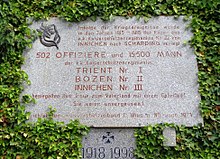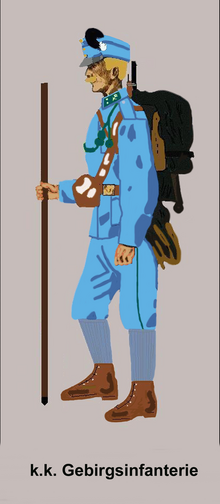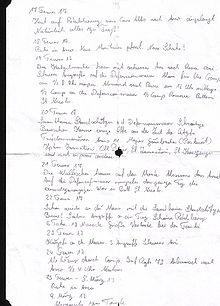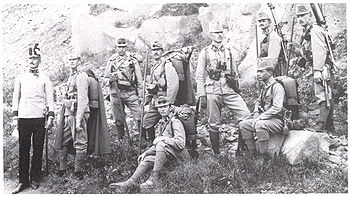Kk Landesschützen
The kk Landesschützen (from January 16, 1917 Kaiserschützen ) were associations of the kk Landwehr of the Austro-Hungarian monarchy established in 1871 . Since 1906 they comprised three infantry regiments trained as mountain troops as well as the "Riding Tyrolean Kaiserschützen / Riding Tyrolean Landesschützen Division" as a mounted component.
Since the associations of the state riflemen within the armed forces of Austria-Hungary belonged to the kk Landwehr , they use the designation "kk" (imperial-royal), while the designation " kuk " was common for the common army .
history
The kk Landwehr existed from 1869 to 1918 in the cisleithan half of the empire as a counterpart to the ku landwehr in the transleithan half of the empire . The special position of Tyrol and Vorarlberg in national defense was adapted to the Austrian Landwehr Act of 1869 in December 1870 with the adoption of the State Defense Act for Tyrol and Vorarlberg by the Tyrolean Parliament. Then one were in 1871 in Tyrol and Vorarlberg nine infantry - battalion built the militia, which one (according to the Tyrol since the 15th and 16th centuries, consisting of historical reasons Marksmen and -kompanien ) the name of the country shooters were. In addition to the infantry units, a mounted division was set up in 1871 with the “Reitende Tiroler Kaiserschützen”.
Organization 1871-1893
The original designation of the ten infantry battalions of the Landesschützen was as follows:
- No. I Lower Inn Valley State Rifle Battalion in Schwaz
- No. II Innsbrucker and Wipptaler Landessschützenbataillon in Innsbruck
- No. III Oberinntaler Landesschützenbataillon in Imst
- No. IV Oberetschtaler Landessschützenbataillon in Meran
- No. V Etsch and Fleimstaler State Rifle Battalion in Bozen
- No. VI Pustertal Rifle Battalion in Bruneck
- No. VII Noce-Avisiotaler Landesschützenbataillon in Mezzolombardo (Welschmetz)
- No. VIII Trient-Valsugana State Rifle Battalion in Trento
- No. IX Rovereto -Sarca State Rifle Battalion in Riva
- No. X Vorarlberg State Rifle Battalion in Bregenz
Each infantry battalion of the Landesschützen had to consist of four field companies and one supplementary company, the latter being a cadre association . Each of the companies employed ten artillerymen to operate assigned guns. In the event of mobilization , the infantry battalions were to serve as base units for the formation of ten additional field battalions and ten reserve battalions.
The mounted units of the Landesschützen set up in 1871 were originally called the Cadre of the Landesschützen on Horseback in Tyrol and Vorarlberg and initially comprised two companies. The task of the mounted units was originally only the reporting, courier and liaison service. In 1874 the mounted units of the Landessschützen were renamed to squadrons , analogous to the rest of the Landwehr cavalry .
Organization 1893–1906
In 1893 the existing ten infantry battalions were converted into three regiments: Landesschützen-Regiment I, II and III (in contrast to all other units of the Austro-Hungarian army, these three regiments were provided with Roman numerals).
In 1894 the mounted state riflemen were given the designation Mounted Tyrolean state riflemen .
In 1903 the Landesschützen-Regiment III was initially disbanded.
Mountain troops 1906–1918
When in the first years of the 20th century the necessity of a pure mountain troop was recognized in Austria-Hungary (based on the example of the Italian Alpini, which had existed for a long time ), the regional riflemen, due to their historical development, literally offered themselves as the core of the new Austrian- Hungarian mountain troops . In the course of the creation of a specialized mountain troop, the two infantry regiments of the state rifles that existed at that time were reclassified to mountain infantry in 1906. The III. The Landesschützen infantry regiment was re-established in 1909 with four battalions. Together with the kk Landwehr Infantry Regiment No. 4 and No. 27, the three Landesschützen regiments formed the Austro-Hungarian mountain troops .
In contrast to the infantry regiments of the state riflemen, the "Riding Tyrolean Landesschützen" were not counted among the Austro-Hungarian mountain troops, but together with the "Riding Dalmatian Landesschützen" formed the cavalry of the mountain associations. In 1912 the mounted Tyrolean state riflemen were renamed "Reitende Tiroler Landesschützen-Division". This division consisted of three squadrons.
Garrisons in August 1914
(As part of the kk Landwehr, the Landesschützen / Kaiserschützen, as is customary there, included the name of the staff garrison in the regimental designation.)
- 88th Landess Rifle Brigade - 44th Landwehr Infantry Division - XIV Army Corps
- Garrison: Staff, I. Baon Trient / II. Baon Strigno / III. Baon Ala / IV. Baon (built in 1913) Rovereto
- 88th Landess Rifle Brigade - 44th Landwehr Infantry Division - XIV Army Corps
- Garrison: Staff, II. Baon Bozen / I. Baon Meran / III. Baon Riva del Garda
- 88th Landess Rifle Brigade - 44th Landwehr Infantry Division - XIV Army Corps
- Garrison: Staff, IV. Baon Innichen / I. Baon Primör / II. Baon Predazzo / III. Baon Cortina d'Ampezzo
- Riding Tyrolean Rifle Division , Commander: Lieutenant Colonel Moritz Srnka
- 3 squadrons
- Garrison: Trento
First World War 1914–1918
Although the state riflemen were actually only allowed to be deployed within Tyrol and Vorarlberg according to the national defense law and the Landwehr law, the state riflemen fought in almost all theaters of war during the First World War. With the vague formulation of the provision “The state riflemen have to provide services outside the borders of Tyrol and Vorarlberg only insofar as the local border conditions and the strategic defense of the state require it; Apart from these two considerations, the state riflemen can only be used as an exception, if Tyrol and Vorarlberg are not threatened in any way, also outside the state, but only with the prior consent of the state parliament. ” the law was circumvented. In particular, the battle of Limanowa-Lapanow ( Galicia ) in December 1914 resulted in an enormous death toll on well-trained men who could not be replaced.
Theaters of war where units of the Landesschützen / Kaiserschützen were deployed are:
- Galicia : Lviv , Grodek , Przemyśl , Pilica , Limanowa-Lapanow , Gorlice-Tarnów , Carpathians
- Serbia
- South Tyrol / Trentino / Carinthia / Krain : Drei Zinnen , Monte Cristallo , Monte Piano , Falzarego , Tofana , Col di Lana , Marmolata , Twelfth Isonzo Battle , Seven Municipalities , Vallarsa , Tonale / Adamello , Ortler
After Italy declared war on its former ally Austria-Hungary in May 1915, the state riflemen returned to Tyrol in autumn 1915, where with their help the mountain front was stabilized and successfully defended.

Hessen-Rainer-Platz,
war memorial with a memorial for the state rifle regiments I, II, III.
On January 16, 1917, on the occasion of a troop visit to Calliano , Emperor Karl I appointed the state riflemen to be Kaiserschützen. He never gave a reason for this, so that ultimately one can only speculate about it.
On the day of the armistice (November 4, 1918) the Kaiserschützen regiments II and III were in position from Zugna Torta via Monte Corno to Monte Spil in Vallarsa. Regiment I lay from south of the Ortler over the Tonale Pass to the Presanella (Adamello- Presanella group). Most of the Kaiserschützen were taken prisoner in Italy: Regiment I in Val di Sole (Sulztal), Regiment II on the Zugna Torta, Regiment III near Folgaria (Vielgereuth).
Awards
The Kaiserschützen were not only characterized by the play cock on the cap and the edelweiss on the collar, but also by:
Officer awards
- 5 Military Maria Theresa Order
- 4 Order of the Iron Crown 2nd class.
- 2 military merit crosses 2nd class
- 29 Order of the Leopold
- 166 Order of the Iron Crown 3rd class.
- 563 Military Merit Crosses 3rd class.
- 427 Signum Laudis in silver
- 1111 Signum Laudis in bronze
- 13 gold medals for bravery for officers
- 14 silver medals of bravery for officers
Team awards
- 130 gold medals for bravery
- 2797 Silver medals for bravery 1st class
- 9820 Silver medals for bravery 2nd class
- 13025 Bronze Medals of Valor
Uniform in the period from 1907
The state riflemen wore the equipment of the mountain troops, which had been introduced in 1907, both in the field and to the parade. This consisted of the following pieces of equipment:
- Pike-gray field cap with attached play tap (in the field the play tap was only put on on command)
- Pike gray blouse with patch pockets and grass green parolis. Officers to parade or on orders with shoulder boards.
- Pike-gray knee breeches with knee-high wool stockings
- Mountain boots
- Officers and batches carried the short saber
This also applied to officers when they took part in a parade within a troop formation. In contrast to this, officers in parade adjustment had to wear the old outfit as an individual (e.g. for the award of medals). This consisted of:
- Hunter's hat with plume
- Pike gray tunic with grass green equalization and shoulder pieces
- Gold / black interwoven field band. Infantry officer's saber.
- Pike-green pantaloons with grass-green piping and lampasses
- Black ankle boots
The individual parade adjustment for officers was composed as follows: The hat of the hunter troop made of matt black, waterproof felt served as parade headgear . It consisted of the neck and brim and was equipped with a green round cord, the hunter's emblem and a plume of black rooster feathers. The hat string was made of sheep's wool, had a push button and at each end an acorn covered with green wool and braided over like a net at the ends. The two acorns were attached to the back of the hat lintel. The cord for officers was made of black woven gold thread.
The lintel was in the shape of an oval cone with a moderately bulged bottom. The brim was laid flat at the back and front, but turned up on both sides. The edge of the brim was edged with black, lacquered calfskin.
On the left side of the lintel there was a backward sloping sleeve made of hat felt to attach the spring bush. The hat emblem - made of gold-colored metal - consisted of the hunter's horn. The Tyrolean eagle made of silver-plated pakfong was attached to the winding light. The emblem was attached over the feather sleeve so that the eagle pointed the same oblique direction as the bush sleeve. The plume was tied in the shape of a cock's tail on a 1.5 mm thick piece of iron wire. The length of the plume was 29 centimeters. The bush was put into the sleeve on the hat, so that the feathers hung down in an arched manner.
The tunic of the shooters was occupied on average of eight silver heads deviating from the infantry with two rows. The buttons bore the regimental number in Roman numerals. On each side of the collar behind the distinction badges there was a matt silver edelweiss.
As a special badge, on the left side of the field cap, there was a small pocket, pointing upwards at an angle, into which a game tap was inserted. In the case of property hats, it happened that the feathers were attached directly to the hat and not tucked into the small pocket in order to better bring out the white down feathers.
The trousers made of pike gray cloth according to the regulations for the German infantry.
Paroli of a chief hunter
annotation
With regard to the other equipment, there were differences to the line infantry .
See under kk mountain troops .
The tradition of the Kaiserschützen is continued (among other things) by the mountain troops of the German Bundeswehr , who still wear the edelweiss of the Kaiserschützen on their hats, which the soldiers of the German Alpine Corps were honored in gratitude when they rushed to the aid of the pressed border in 1915 To protect Tyrol.
Even in the Austrian armed forces, the armed forces stationed in Tyrol and Vorarlberg still wear the edelweiss on their field caps.
As a legacy of the old Austro-Hungarian army, the edelweiss is used as a badge for the Polish mountain hunters (Strzelcy podhalańscy - Carpathian hunters ).
literature
- Georg Bartl: Tiroler Landesschützen - Kaiserschützen. A general review of your development through the ages. Kinderfreundanstalt, Innsbruck 1930, online .
- Maximilian Ehnl: The Austro-Hungarian land power by structure, structure, peace garrison , division and national composition in the summer of 1914 (Austria-Hungary's last war, supplement 9) Vienna 1934. [1]
- Karl Glückmann: The Army of the Austro-Hungarian Monarchy. 12th edition. Seidel, Vienna 1911.
- Oswald Gloßer: On the history of the army in Tyrol, 4th part (conclusion). The period from 1861–1914 . In: Publications of the Museum Ferdinandeum 40 (1960) , Tiroler Landesmuseum Ferdinandeum , Innsbruck 1960.
- Austro-Hungarian War Ministry : Dislocation and division of the Austro-Hungarian Army, the Austro-Hungarian Navy, the Imperial and Royal Landwehr and the Imperial and Royal Landwehr . In: Seidel's small army scheme. Seidel & Sohn, Vienna 1914.
- Austro-Hungarian War Ministry: Adjustment regulation for the Austro-Hungarian Army, the Imperial and Royal Landwehr, the Imperial and Royal Landwehr, the affiliated institutions and the corps of military officials. Vienna 1911/1912.
- Heinz von Lichem : With a play tap and edelweiss. Leopold Stocker Verlag, Graz 1977, ISBN 3-7020-0260-X .
- Walter Wagner : The K. (U.) K. Army - structure and tasks . In: Adam Wandruszka , Peter Urbanitsch (ed.): The Habsburg Monarchy 1848–1918. Volume V The Armed Power . Publishing house of the Austrian Academy of Sciences, Vienna 1987 ISBN 3 7001 1122 3 .
Footnotes
- ↑ "Division" in the Austro-Hungarian Army referred to a battalion-strength unit. For a division in the sense of a large military unit, the term "infantry" or "cavalry troop division" was used
- ^ Walter Wagner: The K. (U.) K. Army - structure and tasks p. 420
- ↑ Oswald Gschliesser: The History of the military system in Tyrol, Part 4 (Final). The period from 1861–1914 pp. 80–81













